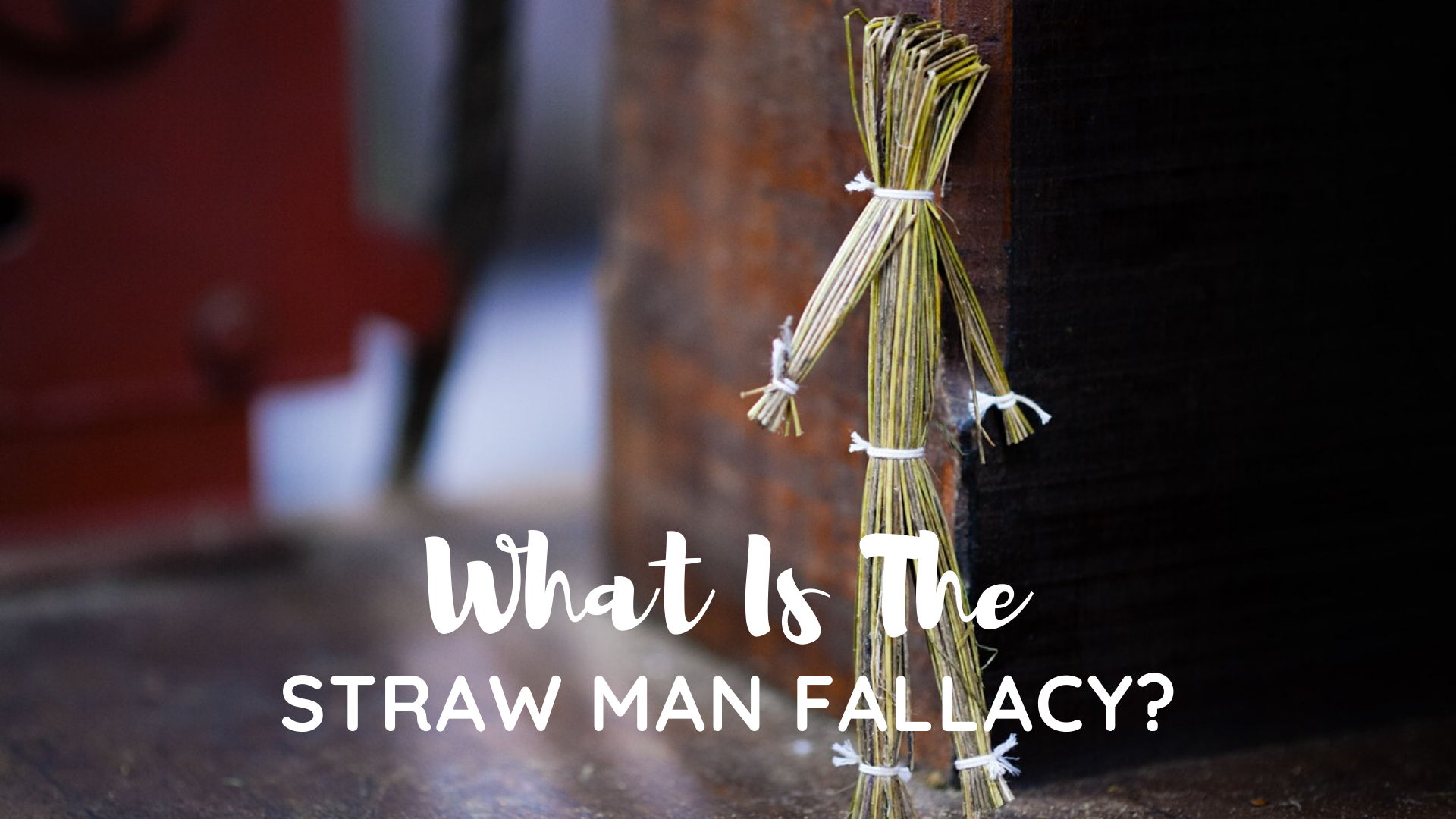
The straw man argument is an informal logical fallacy or rhetorical technique where someone creates a characterization of another person’s argument and then refutes that argument while claiming to have refuted the original argument. In other words, they deal with an argument that wasn’t made in the first place, distorting it and creating a “strawman” to knock down and claim that they have refuted the original argument.
“A drowning man will clutch at a straw.” — Thomas Moore
The origin of the phrase strawman is unclear, but it is believed that the first time the phrase was used was in Guides to Straight Thinking from 1956 by Stuart Chase.
The Format Of A Strawman
The general form of the strawman fallacy goes like this:
One person states a position. Another person creates a dishonest, distorted, or otherwise inaccurate version of person’s original argument. They pretend that there is no difference between the original argument and their version of the argument. The second person then tries to refute their own version of the argument and acts as if the original argument has been refuted.
Let’s look at a few examples:
- Person A: “I don’t think adding more money to the defense budget is a good use of our resources at the moment.” Person B: “So you’re saying that we shouldn’t invest in the military at all and leave the nation without a form of defense? That’s absurd, we need a military to deter rogue nations or bad actors in the world from harming our people.”
- Person A: “I think we should invest in more research to find solutions for drug-resistant bacteria.” Person B: “It’s very suspicious that you want to give a blank check to big pharmaceutical companies. Pharmaceutical companies are only out to make a profit and you are suggesting giving them the means to make more profit.”
In these instances, Person B responded with a distortion of Person A’s argument, something Person A never actually said. They have created a strawman. The presence of the strawman indicates that there is a logical flaw within the argument given by the second person in their attempt to refute the first argument. Philosophers often consider the strawman argument a type of informal fallacy, that is, not a formal logical fallacy where the deduction is incorrect due to a flawed pattern of reasoning. In the case of the strawman, the person using the strawman is trying to undermine an argument not relevant to the original argument and the primary discussion.

Photo: kabaldesch0 via Pixabay, CC0
Versions Of Strawmen
It’s important to remember that the conclusion of a strawman argument does not need to be incorrect or logically fallacious. It’s entirely possible for a strawman argument to have a correct conclusion and still be a strawman. In fact, strawmen are often intentionally set up to gain easier access to a correct conclusion that undermines an argument (just not the argument that was originally made). What’s relevant in the recognition of a strawman is that the original argument was misrepresented by the other party.
“It’s clear from the beginning that this is not a real science discussion. This is a showcase for intelligent design. They have created a straw man. They are trying to make science stand for atheism so they can fight atheism.” — Jack Krebs
Though not a formal fallacy, the strawman is one of the more common (if not amongst the most common) logical fallacies. The strawman can manifest itself in a wide variety of ways. Some ways a strawman fallacy can manifest include:
- Quote mining – using parts of an original argument out of context in order to create a misrepresentation of that argument.
- Using extreme examples or opinions that, while sometimes used to support similar arguments, were not invoked by the person themselves.
- Cherry-picking – only addressing one specific part of the argument and ignoring the other parts of the argument, another form of taking a phrase or argument out of context.
- If an opponent is a member of a group, one may attempt a form of guilt by association and use the weakest arguments presented by other members of the group as a representation of what everyone in the group believes.
- In general, creating unfair oversimplifications or exaggerations of another person’s argument.
You can try to counter a strawman by pointing out that the argument you made and their characterization of your argument is not the same. Ask them to explain how the strawman and your argument are the same.
Watching Out For Your Own Strawmen (And Demonstrating The Principle of Charity)

Photo: SteenJepsen via Pixabay, CC0
It should be recognized that one can create a strawman unintentionally. This is due to the fact that people often misunderstand another person’s argument. This happens to everyone, even those well versed in logic and rhetoric, so if you suspect a strawman has been made out of your argument you may wish to simply clarify your argument or ask the other person to account for their employment of the strawman, rather than assuming ill will and attacking them for creating a strawman. It’s also important to be aware of the fact that you yourself can create strawmen and to avoid making them.
“When your opponent sets up a straw man, set it on fire and kick the cinders around the stage. Don’t worry about losing the Strawperson-American community vote.” — James Lileks
Creating a strawman of another person’s argument and then attempting to refute that argument is highly unlikely to convince the other person their argument is incorrect because it wasn’t the argument they made to begin with. For this reason, if your goal is to persuade the other person, avoid making strawmen. A good way to ensure that you aren’t creating a strawman of your interlocutor’s position is to restate your opponent’s position. This helps make sure you two are on the same page and may make them more receptive to critical arguments by showing them you are putting in the effort to understand them.
Philosopher Daniel Dennett expanded upon suggestions made by Anatol Rapoport, a psychologist to explain how to format a successful critical commentary:
- “You should attempt to re-express your target’s position so clearly, vividly, and fairly that your target says, ‘Thanks, I wish I’d thought of putting it that way.’
- You should list any points of agreement (especially if they are not matters of general or widespread agreement).
- You should mention anything you have learned from your target.
- Only then are you permitted to say so much as a word of rebuttal or criticism.”
A variant of the strawman fallacy is something called the steel-man, which involves using the best possible version of your opponent’s argument in the discussion, basically making the argument more difficult for you to defeat. This is done under the principle of charity. This helps make your interlocutor more open to criticism and make conversations more productive by not wasting time clearing up strawmen.









